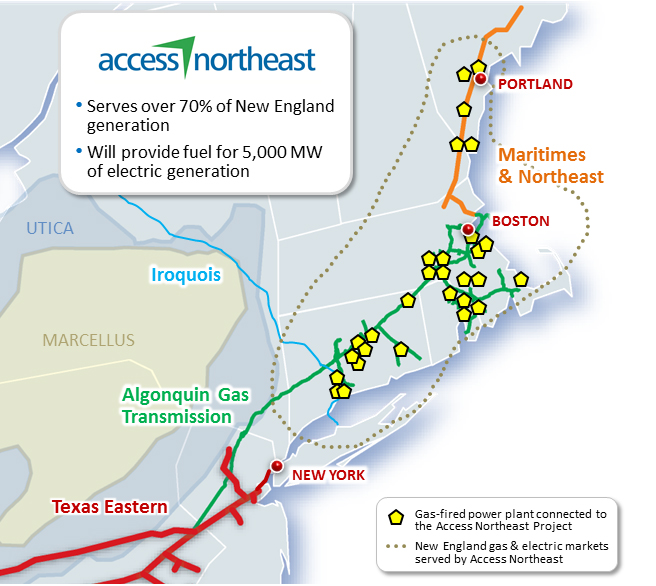Another Pipeline Project Planned for Burrillville
June 6, 2016

BURRILLVILLE, R.I. — This rural community is again fighting a natural gas project. This one, however, isn’t a power plant but another buildout of the town’s pipeline compressor station. The Algonquin facility, owned by Spectra Energy Corp. of Houston, expanded last year despite several protests and opposition from neighbors and environmental activists.
As part of a second phase of regional projects, Spectra wants to enlarge the compressor station by adding two more gas-powered engines, which propel natural gas along the 1,127-mile Algonquin pipeline that runs from New Jersey to Massachusetts.
Neighbors are already complaining about a persistent noise and periodic jet engine-like sounds that followed the 2015 expansion. The noise exceeds local ordinance levels, prompting the town to request that Spectra switch from gas-powered to less-noisy electric compressors. Electric engines also reduce air pollution and improve safety at the compressor station, according to the town.
“The Town Council is obliged to protect the health and welfare of all town residents,” according to a May 31 letter to federal energy officials signed by Town Council President John Pacheco III.
The compressor engines, some dating to 1961, sit next to the proposed site for the $700 million Clear River Energy Center power plant. A 15,900-horsepower industrial compressor was added last year as one of Spectra’s 13 regional pipeline projects, called the Algonquin Incremental Market Project. The project required clearing 6 acres of forested land. Neighbors are now complaining about added noise from the facility.
The Pacheco letter explains that residents are concerned about added noise and vibration from further expansion, which according to Spectra already exceed the town’s noise ordinance. The town now wants Spectra to fix the noise problem with new equipment or at least fund a study of the noise impacts. The town is requesting similar monitoring and equipment upgrades to address harmful emissions such as benzene, carbon monoxide and volatile organic compounds.
Terrorism also is a concern. Pacheco’s letter notes that gas and oil pipelines have been targeted outside the United States and, therefore, fencing, security cameras, guards and a security plan should be established to deter attacks and accidents. Potential explosions also require a study of the blast radius and at-risk property within that zone, according to the town.
“While there is no specific credible reporting indicating that similar attacks will occur in the United States, the fact that such attacks have occurred abroad raises the possibility that similar attacks could occur here,” according to the letter.
Although no major accidents have occurred at the Burrillville facility, explosions and fires occur periodically at natural-gas pipelines and compressors stations. Most recently, on April 29, one man was severely burned when a section of a Spectra natural-gas pipeline exploded in Salem Township, Pa. The blast created a 1,500-square-foot hole and burned 40 acres.
The town wants notifications of the periodic thunderous venting, called “blowdowns,” which are heard throughout the area and trigger 911 calls by residents. The letter also seeks a cost analysis of acquiring emergency supplies, equipment and training for police and firefighters, and money to recover from possible spills, leaks, evacuations and explosions.
“Additionally the chemicals emitted during the blowdowns are a concern to the citizens of Burrillville. Also, some people have been able to drive to the facility without being stopped or questioned. This is not safe and is a concern for all,” resident Christena Schofield wrote in a letter to the Federal Energy Regulatory Commission (FERC).
The compressor station project is hardly an isolated expansion of natural-gas energy infrastructure. Spectra, along with electric utilities National Grid and Eversource Energy, are developing multiple natural-gas projects in southern New England. The series of projects, called Access Northeast, include compressor-station expansion and new liquefied natural gas infrastructure that coincide with five proposed natural gas power plants along the Algonquin pipeline.
Access Northeast is in the pre-filing stage with FERC. Although public hearings and environmental reviews are expected, many environmental and climate activists consider the FERC application process a rubber-stamp approval for oil and gas projects. Protests occur regularly outside FERC’s office in Washington, D.C., in hopes of ending the fossil fuel industry’s perceived influence on FERC. Protesters also oppose the proposed projects along Spectra’s Algonquin natural gas pipeline.
Spectra, National Grid and Eversource say building new power plants and expanding natural-gas infrastructure is necessary to replace retiring power plants, such as the 1,500-megawatt Brayton Point Power Station in Somerset, Mass., and the 685-megawatt Pilgrim Nuclear Power Station in Plymouth, Mass.
The power companies say New England will save money by bringing in cheaper natural gas from neighboring states where natural gas is extracted.
“The price of inaction is billions of dollars out of consumers’ pockets and the risk of electricity and heat not being available when people need them most,” according to an Access Northeast project document.
Four new natural gas power plants are being built or are proposed in addition to the Clear River Energy Center: the 785-megawatt CPV Towantic Energy Center in Oxford, Conn.; the 674-megawatt Salem Harbor facility in Salem, Mass.; a 200-megawatt power-plant expansion in Medway, Mass.; and an expansion of the Wallingford Power Plant in Wallingford, Conn.
The proposed natural gas liquefaction plant on the Providence waterfront is not one of the Access Northeast projects, but it is being developed by National Grid. Other Access Northeast projects in southern New England include 123 miles of new pipeline, expansion of seven compressor stations, a new compressor engine at a yet-to-be built compressor station in Weymouth, Mass., and a liquefied-natural-gas peaking facility. The first phase of Access Northeast aims to be completed in 2018.
Categories
Join the Discussion
View CommentsRecent Comments
Leave a Reply
Related Stories
Your support keeps our reporters on the environmental beat.
Reader support is at the core of our nonprofit news model. Together, we can keep the environment in the headlines.
We use cookies to improve your experience and deliver personalized content. View Cookie Settings




It is a shame you don’t do an article on the environmental surroundings of this combined compressor plant and power plant proposal. The 1995 Resource Protection Project, a huge project enlisting over 100 people from various state agencies, NGO’s and universities, provides the baseline data and mapping that—if brought to the public’s attention—would reveal of folly of this power plant’s proposed location in tandem with the compressor expansion. The map alone would show the story, and also squelch the claims of the union leaders who have said "You never hear any complaints about the Ocean State plant," (Ocean State, 560 megawatts, has been operating in Eastern Burrillville for twenty-six years.) That’s because the Ocean State plant’s site isn’t any where near so ecologically sensitive as Invenergy’s. You should call up Rick Enser, former DEM head of the Natural Heritage Program and talk you for a walk in the woods up there. The people who principal concern is the climate effect of this plant are ignoring a powerful, detailed, clearly mapped argument for opposing this plant, and a set of potential allies in the traditional conservation community in our state.
I know I’m preaching to the choir, but why are we building more fossil fuel infrastructure that will last decades when we need to be switching to renewable energy? Methane leaked from natural gas will cause worse climate change damage in the long run than carbon dioxide from other fossil fuels and it causes environmental degradation of groundwater, surface water, air, and land where it is fracked, plus increased earthquakes. It is not a clean energy bridge, but a bridge to rising sea levels. We need to band together to stop more fossil fuel infrastructure and demand a renewable energy future now.